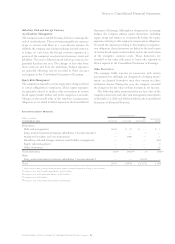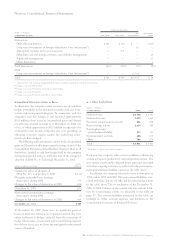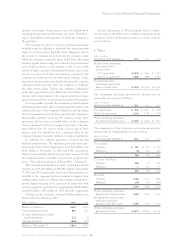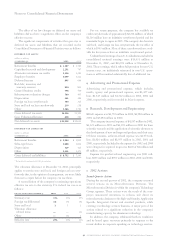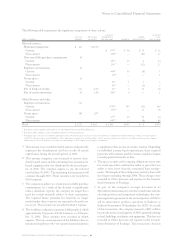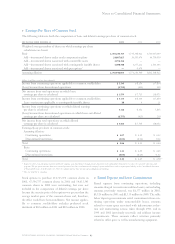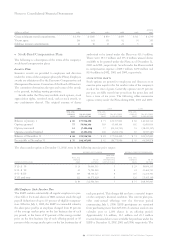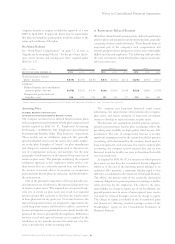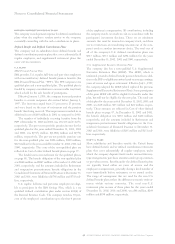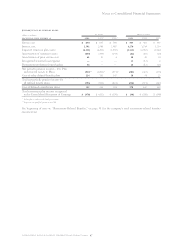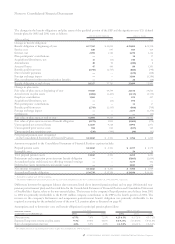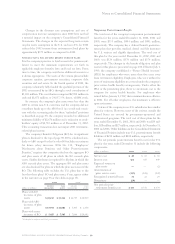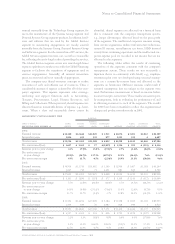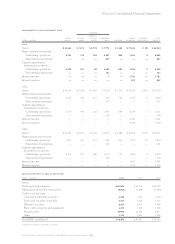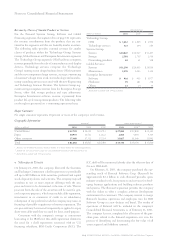IBM 2002 Annual Report Download - page 97
Download and view the complete annual report
Please find page 97 of the 2002 IBM annual report below. You can navigate through the pages in the report by either clicking on the pages listed below, or by using the keyword search tool below to find specific information within the annual report.
Notes to Consolidated Financial Statements
95international business machines corporation and Subsidiary Companies
(dollars in millions) u.s. non-u.s. total
for the year ended december 31: 2002 2001 2000 2002 2001 2000 2002 2001 2000
Total retirement-related
plans
—
income $«(154) $«(256) $«(156) $«(17) $«(181) $«(171) $«(171) *$«(437) *$«(327) *
Comprise:
Defined benefit and contribution
pension plans
—
income $«(478) $«(632) $«(530) $«(46) $«(209) $«(198) $«(524) $«(841) $«(728)
Nonpension postretirement
benefits
—
cost 324 376 374 29 28 27 353 404 401
*Includes amounts for discontinued operations costs of $77 million, $56 million and $62 million for 2002, 2001 and 2000, respectively.
company intends to request stockholder approval of a new
ESPP in April 2003. If approved, shares may be issued under
that plan and employee participation would be subject to the
terms and conditions of that plan.
Pro Forma Disclosure
See “Stock-Based Compensation” on page 72, in note a,
“Significant Accounting Policies,” for the pro forma disclo-
sures of net income and earnings per share required under
SFAS No. 123.
wRetirement-Related Benefits
IBM offers defined benefit pension plans, defined contribution
pension plans and nonpension postretirement plans, primarily
consisting of retiree medical benefits. These benefits form an
important part of the company’s total compensation and
benefits program that is designed to attract and retain highly
skilled and talented employees. The following table provides
the total retirement-related benefit plans’ impact on income
before income taxes.
Accounting Policy
defined benefit pension and
nonpension postretirement benefit plans
The company accounts for its defined benefit pension plans
and its nonpension postretirement benefit plans using actuarial
models required by SFAS No. 87, “Employers’ Accounting
for Pensions,” and SFAS No. 106, “Employers’ Accounting for
Postretirement Benefits Other Than Pensions,” respectively.
These models use an attribution approach that generally
spreads individual events over the service lives of the employ-
ees in the plan. Examples of “events” are plan amendments
and changes in actuarial assumptions such as discount rate,
rate of compensation increases and mortality. See the next
paragraph for information on the expected long-term rate of
return on plan assets. The principle underlying the required
attribution approach is that employees render service over
their service lives on a relatively smooth basis and therefore,
the income statement effects of pensions or nonpension
postretirement benefit plans are earned in, and should follow,
the same pattern.
One of the principal components of the net periodic pen-
sion (income)/cost calculation is the expected long-term rate
of return on plan assets. The required use of expected long-
term rate of return on plan assets may result in recognized
pension income that is greater or less than the actual returns
of those plan assets in any given year. Over time, however, the
expected long-term returns are designed to approximate the
actual long-term returns and therefore result in a pattern of
income and expense recognition that more closely matches the
pattern of the services provided by the employees. Differences
between actual and expected returns are recognized in the
calculation of net periodic pension (income)/cost over five
years as provided for in the accounting rules.
The company uses long-term historical actual return
information, the expected mix of investments that comprise
plan assets, and future estimates of long-term investment
returns to develop its expected return on plan assets.
The discount rate assumptions used for pension and non-
pension postretirement benefit plan accounting reflect the
prevailing rates available on high-quality, fixed-income debt
instruments. The rate of compensation increase is another
significant assumption used in the actuarial model for pension
accounting and is determined by the company, based upon its
long-term plans for such increases. For retiree medical plan
accounting, the company reviews external data and its own
historical trends for health care costs to determine the health
care cost trend rates.
As required by SFAS No. 87, for instances in which pension
plan assets are less than the accumulated benefit obligation
(ABO) as of the end of the reporting period (defined as an
unfunded ABO position), a minimum liability equal to this
difference is established in the Statement of Financial Position.
The ABO is the present value of the actuarially determined
company obligation for pension payments assuming no further
salary increases for the employees. The offset to the mini-
mum liability is a charge to equity, net of tax. In addition, any
prepaid pension asset in excess of unrecognized prior service
cost must be reversed through a net-of-tax charge to equity.
The charge to equity is included in the Accumulated gains
and (losses) not affecting retained earnings section of the
Stockholders’ equity in the Consolidated Statement of
Financial Position.


